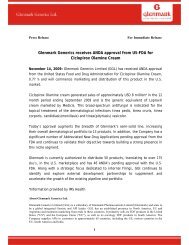Download - Glenmark
Download - Glenmark
Download - Glenmark
You also want an ePaper? Increase the reach of your titles
YUMPU automatically turns print PDFs into web optimized ePapers that Google loves.
The Group’s internal drug development expenditures are capitalised only if they meet the recognition criteria as<br />
mentioned above. Where uncertainties are such that the criteria are not met, the expenditures are recognised in<br />
income statement as incurred. Where, however, the recognition criteria are met, intangible assets are capitalised<br />
and amortised on a straight-line basis over their useful economic lives from product launch. During the periods<br />
prior to their launch (including periods when such products have been out-licenced to other companies), these<br />
assets are tested for impairment on an annual basis, as their economic useful life is indefinite till then.<br />
Payments to in-license products and compounds from third parties generally taking the form of up-front payments<br />
and milestones are capitalised and amortised, generally on a straight-line basis, over their useful economic lives<br />
from product launch. During the periods prior to their launch, these assets are tested for impairment on an<br />
annual basis, as their economic useful life is indefinite till then.<br />
De-recognition of intangible assets<br />
Intangible assets are de-recognised either on their disposal or where no future economic benefits are expected<br />
from their use or disposal. Losses arising on such de-recognition are recorded in income statement, and are<br />
measured as the difference between the net disposal proceeds, if any, and the carrying amount of respective<br />
intangible assets as on the date of de-recognition.<br />
Intangible assets relating to products in development, other intangible assets not available for use and intangible<br />
assets having indefinite useful life are subject to impairment testing at each reporting date. All other intangible<br />
assets are tested for impairment when there are indications that the carrying value may not be recoverable. Any<br />
impairment losses are recognised immediately in the income statement.<br />
Other intangible assets<br />
Other intangible assets that are acquired by the Group, which have finite useful lives, are measured at cost less<br />
accumulated amortisation and accumulated impairment losses.<br />
Subsequent expenditures are capitalised only when they increase the future economic benefits embodied in the<br />
specific asset to which they relate.<br />
Software for internal use, which is primarily acquired from third-party vendors, including consultancy charges for<br />
implementing the software, is capitalised. Subsequent costs are charged to the income statement as incurred.<br />
The capitalised costs are amortised over the estimated useful life of the software.<br />
Amortisation<br />
Amortisation is recognised in income statement on a straight-line basis over the estimated useful lives of<br />
intangible assets, other than for goodwill, intangible assets not available for use and intangible assets having<br />
indefinite life, from the date that they are available for use.<br />
The estimated useful lives are as follows:<br />
Product related intangibles<br />
10 years<br />
Other intangibles<br />
5 years<br />
3.10 IMPAIRMENT TESTING OF FINANCIAL ASSETS, GOODWILL, INTANGIBLE ASSETS AND PROPERTY,<br />
PLANT AND EQUIPMENT<br />
Financial assets<br />
A financial asset is assessed at each reporting date to determine whether there is any objective evidence that it<br />
is impaired. A financial asset is considered to be impaired if objective evidence indicates that one or more events<br />
had a negative effect on the estimated future cash flows of that asset.<br />
An impairment loss, in respect of a financial asset measured at amortised cost is calculated as the difference<br />
between its carrying amount, and the present value of the estimated future cash flows discounted at the original<br />
effective interest rate. An impairment loss, in respect of an available-for-sale financial asset is calculated by<br />
reference to its fair value.<br />
Individually significant financial assets are tested for impairment on an individual basis. All impairment losses<br />
are recognised in income statement. Any cumulative loss in respect of an available-for-sale financial asset<br />
recognised previously in equity is transferred to income statement. An impairment loss is reversed if the reversal<br />
can be related objectively to an event occurring after the impairment loss was recognised. For financial assets<br />
measured at amortised cost and available-for-sale financial assets that are debt securities, the reversal is<br />
recognised in income statement. For available-for-sale financial assets that are equity securities, the reversal is<br />
recognised in Other Comprehensive Income.<br />
Non-financial assets<br />
The carrying amounts of the Group’s non-financial assets, other than inventories and deferred tax assets are<br />
reviewed at each reporting date to determine whether there is any indication of impairment. If any such indication<br />
exists, then the asset’s recoverable amount is estimated. For goodwill and intangible assets that have indefinite<br />
lives or that are not yet available for use, the recoverable amount is estimated each year at the same time.<br />
The recoverable amount of an asset or cash-generating unit (as defined below) is the greater of its value in use<br />
or its fair value less costs to sell. In assessing value in use, the estimated future cash flows are discounted to<br />
their present value using a pre-tax discount rate that reflects current market assessments of the time value of<br />
Annual Report 2010-2011 87



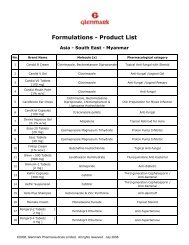


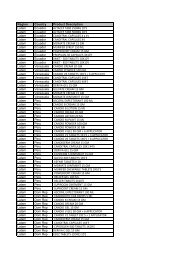
![Formulations [India] â Product List - Glenmark](https://img.yumpu.com/46601329/1/190x245/formulations-india-a-product-list-glenmark.jpg?quality=85)
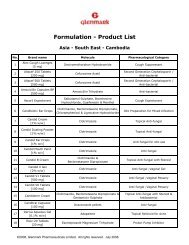
![Formulation [India] â Product List - Glenmark](https://img.yumpu.com/44013338/1/190x245/formulation-india-a-product-list-glenmark.jpg?quality=85)


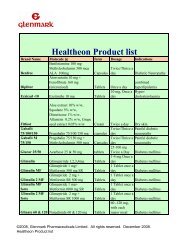
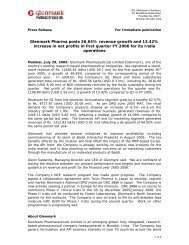
![Formulations [India] â Product List - Glenmark](https://img.yumpu.com/35994839/1/190x245/formulations-india-a-product-list-glenmark.jpg?quality=85)
